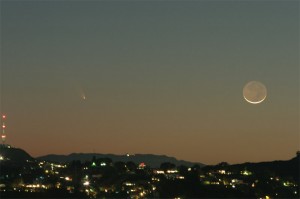![]() LISTEN to this week’s Sky Report
LISTEN to this week’s Sky Report
This is the Griffith Observatory Sky Report for the week ending Wednesday, March 20, 2013. Here is what’s happening in the skies of Southern California:
 Comet PANSTARRS C/2011 L4 is now at its best in the evening sky. The comet can be found about 12 degrees above the western horizon starting 30 minutes after sunset this week. Comet PANSTARRS is easy to see in binoculars, appearing as a star, sprouting a hazy tail that streams to the upper left. The tail tends to become most visible shortly before the comet sets, when the sky is nearly dark. So far, only the brightest ½ degree of tail is visible, but the tail may appear longer as the comet moves away from the sun. You can see comet PANSTARRS from Wednesday to Sunday between about 7:30 p.m. and 8:00 through telescopes and binoculars at Griffith Observatory this week. On Wednesday, March 13th, the crescent moon will appear 11 degrees above the comet. Charts and other information to help you find comet PANSTARRS appears on our special comet web page. (Photograph by Anthony Cook, Griffith Observatory, March 12, 2013)
Comet PANSTARRS C/2011 L4 is now at its best in the evening sky. The comet can be found about 12 degrees above the western horizon starting 30 minutes after sunset this week. Comet PANSTARRS is easy to see in binoculars, appearing as a star, sprouting a hazy tail that streams to the upper left. The tail tends to become most visible shortly before the comet sets, when the sky is nearly dark. So far, only the brightest ½ degree of tail is visible, but the tail may appear longer as the comet moves away from the sun. You can see comet PANSTARRS from Wednesday to Sunday between about 7:30 p.m. and 8:00 through telescopes and binoculars at Griffith Observatory this week. On Wednesday, March 13th, the crescent moon will appear 11 degrees above the comet. Charts and other information to help you find comet PANSTARRS appears on our special comet web page. (Photograph by Anthony Cook, Griffith Observatory, March 12, 2013)
The waxing moon will change phase to first quarter on Tuesday the 19th, and will appear waxing gibbous starting on the 20th.
Jupiter, in Taurus the Bull, remains the brightest evening planet, and is high in the western sky when darkness falls. Jupiter sets in the west-northwest at 12:45 a.m. The moon will pass less than 2 degrees south of Jupiter on Sunday the 17th.
The ringed planet Saturn, in Libra the Scales, is visible as a bright golden object in the southeast sky after it rises at 10:20 p.m. Saturn transits 43 degrees above the southern horizon at 3:45 a.m.
Early-risers can see the International Space station pass over Los Angeles on the morning of March 15. The brilliant satellite will emerge from earth’s shadow, to the upper right of Saturn, at 5:46 a.m., P.D.T., while 46 degrees high in the southwest. It will be nearly overhead a minute later, and will reach the northeast horizon at 5:49 a.m.
Spring begins at 4:02 a.m., P.D.T. on Wednesday, March 20. This is the moment that the sun appears to cross the celestial equator, moving from south to north. Spring will end with the start of summer on June 20. Special observances of solar noon and sunset will take place on the 20th at Griffith Observatory.
Free views of the sun during the day and of the moon, planets, and other celestial objects at night, are available to the public in clear weather through Griffith Observatory’s telescopes Wednesday-Sunday before 9:30 p.m. Check our website for our schedule. The next public star party on the grounds of Griffith Observatory, hosted by the Los Angeles Astronomical Society, the Sidewalk Astronomers, and the Planetary Society, will take place between 2:00 p.m. and 9:30 p.m. on Saturday, March 16th. Remember to arrive before 7:00 p.m. to see comet PANSTARRS.
From Griffith Observatory, I’m Anthony Cook and I can be reached at griffithobserver@gmail.com.
